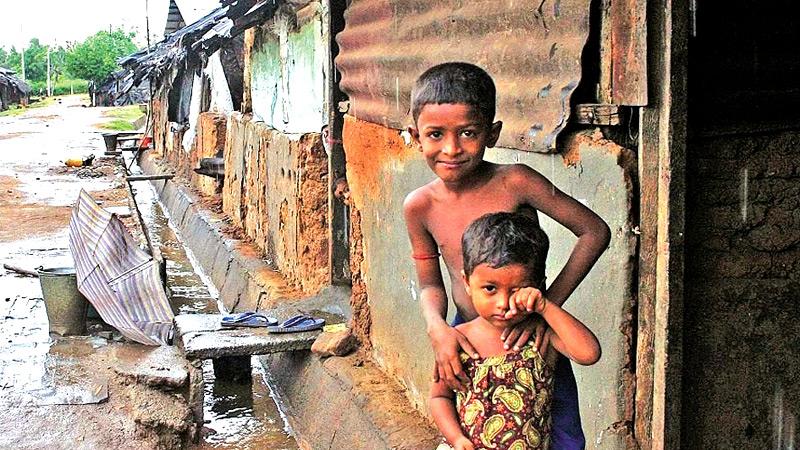
According to the 2016............ statistics, 4.1per cent of our population lives below the national poverty line. When we compare it with the 1990 figures, which was 26.1 per cent, we can be happy with the progress. Over the past few decades Sri Lanka has made significant strides to reduce poverty but, there are ongoing challenges in understanding the complex nature of poverty and how it could be tackled.
It is not sufficient to consider the income angle only when monitoring poverty, as there are multiple dimensions of poverty. Many Sri Lankans live just above the National Poverty Line (NPL). For example, more than 400,000 persons fall within 10 per cent above the NPL and around one million live within 20 per cent above the NPL. Although only 1.9 per cent of the population in Sri Lanka are in multidimensional poverty (MDP), 9.5 percent are close to MDP.
These are problematic statistics, and therefore it is important to have a broader outlook at poverty, when developing strategies to alleviate it. The methodology currently used in the determination of NPL is often debated.
Most experts recommend that we rebase the NPL, which was developed in 2004 based on Household Income and Expenditure Survey (HIES)-2002 of the Department of Census and Statistics. The spending and consumption patterns of the poor change with time. Their expenditure pattern in 2004 is radically different to what it would be in 2020. Therefore, it is a ‘must’ for the basis of NPL to be changed to meet the current situation.
There are numerous causes for poverty in Sri Lanka. The main causes can be listed as follows:
Geographic location
Although the overall poverty rate in Sri Lanka has decreased since the 1990s, there are identifiable geographic areas that face poverty at a much higher rate than average. Regions far from urban and commercial centres experience the most poverty. Nine out of ten people facing poverty in the country live in rural areas. These regions lack modern infrastructure facilities, human capital resources and proximity to large markets.
The Western Province has the lowest poverty rate. It has many agriculture and trade facilities, seaport and international airport, and a large urban centre that has created jobs and wealth in the area. Companies are more likely to invest in the Western Province than in other areas.
In the other provinces, most people find work in the informal sector due to the distance from commercial centres. Poor roads and transportation facilities do not help the spread of wealth to remote areas.
Agriculture as a main source of income
In households where the main income earner is employed in the agriculture sector, the poverty rate is found to be 40 percent. This is the highest incidence of poverty across business sectors in the country. The wages for rice farmers has remained stagnant over the years.
The rice industry is very inefficient and the government does not invest funds in research to improve productivity. Inadequate funding of the canals and irrigation system has caused many apparatuses to fail, which further reduces productivity.
Among the other causes of poverty is living in a poor household. Many of them have no means of escaping from poverty. It is difficult for poor people to save money for emergencies such as illness or death.
Children in poor households often have to choose between working and education. While working will benefit their families immediately, education will ensure them better employment in the long run.
Unfocused education system
Another main cause of poverty is the current education system, which is not designed to give students the skills needed for employment. The curriculum is based on abstraction and learning through repetition. Around 62 per cent of the GCE qualified students do not have sufficient knowledge in mathematics and an international language. They are neither prepared for employment nor for further education.
Any program aiming at reducing the poverty gap must explore the four main causes before venturing inside.
Rural population
Poverty occurs in concentrated pockets, for example, former conflict districts such as Mullaitivu and Manner have a high percentage of extreme poverty. They are also high in the Batticaloa and Moneragala districts.
About 85 percent of Sri Lanka’s poor live in rural districts, which often lack access to quality education. Even pre-schools, for example, are often private and profit oriented, oftentimes inaccessible to poor families.
Lack of quality education leads to rampant unemployment. Reportedly 28 percent of the youth, aged 15 to 24, are not receiving an education, training for future employment nor are they employed. Hence living standards in rural areas are low, leading to undernourishment and stunting. An overall 22.1 percent of the population is undernourished, while 17.1 per cent of children under the age of five are malnourished, and 17.3 per cent of children under five are stunted in growth.
About 4.4 per cent of Sri Lankans still lack access to electricity, and the benefit of technology. Without technology or internet, they do not have any access to opportunities that could help lift them out of poverty.
Meanwhile, rural women especially, are not economically active. Gender roles in Sri Lanka dictate that women do the bulk of unpaid care work in their households. Women are often responsible for rearing and educating the children, caring for the elderly or sick family members, cooking and collecting water for daily consumption in rural areas.
Sri Lanka’s growth rate reached a 16-year low in 2017 at 3.1 per cent. Thus the rate of economic growth is in decline.
The country still has a long road ahead recovering from the ongoing economic and environmental crises, but we also need to concentrate on our poverty issue, for a better future.
